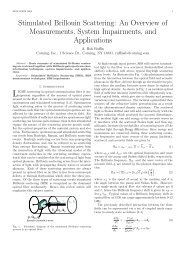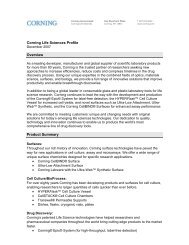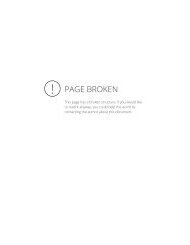Create successful ePaper yourself
Turn your PDF publications into a flip-book with our unique Google optimized e-Paper software.
Quantitative and Qualitative Disclosures About Market Risks<br />
We operate and conduct business in many foreign countries and as a result are exposed to movements in foreign currency exchange<br />
rates. Our exposure to exchange rates have the following effects:<br />
• exchange rate movements on financial instruments and transactions denominated in foreign currencies which impact earnings, and<br />
• exchange rate movements upon conversion of net assets and net income of foreign subsidiaries for which the functional currency<br />
is not the U.S. dollar, which impact our net equity.<br />
Our most significant foreign currency exposure is the Japanese yen and to a much lesser extent the Korean won, the Taiwan dollar,<br />
and the Euro. We selectively enter into foreign exchange forward and option contracts with durations generally 18 months or less to<br />
hedge our exposure to exchange rate risk on foreign source income and purchases. These hedges are scheduled to mature coincident<br />
with the timing of the underlying foreign currency commitments and transactions. The objective of these contracts is to neutralize the<br />
impact of exchange rate movements on our operating results. We also enter into foreign exchange forward contracts when situations<br />
arise where our foreign subsidiaries or <strong>Corning</strong> enter into lending situations, generally on an intercompany basis, denominated in<br />
currencies other than their local currency. We do not hold or issue derivative financial instruments for trading purposes. <strong>Corning</strong> uses<br />
derivative instruments (forwards) to limit the exposure to foreign currency fluctuations associated with certain monetary assets and<br />
liabilities. These derivative instruments are not designated as hedging instruments for accounting purposes and, as such, are referred<br />
to as undesignated hedges. Changes in the fair value of undesignated hedges, along with foreign currency gains and losses arising<br />
from the underlying monetary assets or liabilities, are recorded in current period earnings in the other income, net component in the<br />
consolidated statement of operations.<br />
Equity in earnings of affiliated companies has historically contributed a significant amount to our income from continuing operations.<br />
Equity in earnings of affiliated companies, net of impairments was $942 million in <strong>2007</strong> and $960 million in 2006 with foreign-based<br />
affiliates comprising over 63% of this amount in <strong>2007</strong>. Equity earnings from Samsung <strong>Corning</strong> and Samsung <strong>Corning</strong> Precision<br />
totaled $532 million for <strong>2007</strong> and $555 million for 2006. Exchange rate fluctuations and actions taken by management of these<br />
entities can affect the earnings of these companies.<br />
We use a sensitivity analysis to assess the market risk associated with our foreign currency exchange risk. Market risk is defined as<br />
the potential change in fair value of assets and liabilities resulting from an adverse movement in foreign currency exchange rates. At<br />
December 31, <strong>2007</strong>, we had open forward contracts, and foreign denominated debt with values exposed to exchange rate movements,<br />
all of which were designated as hedges at December 31, <strong>2007</strong>. A 10% adverse movement in quoted foreign currency exchange rates<br />
could result in a loss in fair value of these instruments of $239 million. Specific to the Japanese yen, a 10% adverse movement in<br />
quoted yen exchange rates could result in a loss in fair value of these instruments of $146 million.<br />
As we derive approximately 70% of our net sales from outside the U.S., our sales and net income could be affected if the U.S. dollar<br />
significantly strengthens or weakens against foreign currencies, most notably the Japanese yen and Euro. Our outlooks included in<br />
Management’s Discussion and Analysis assume exchange rates during 2008 remain constant at January 2008 levels. A plus or minus<br />
10 point movement in the U.S. dollar - Japanese yen exchange rate would result in a change to 2008 net sales of approximately $239<br />
million and net income of approximately $220 million. A plus or minus 10 point movement in the U.S. dollar - Euro exchange rate<br />
would result in a change to 2008 net sales of approximately $61 million and net income of approximately $12 million.<br />
Interest Rate Risk Management<br />
It is our policy to conservatively manage our exposure to changes in interest rates. At December 31, <strong>2007</strong>, our consolidated debt<br />
portfolio contained less than 34% of variable rate instruments.<br />
41







